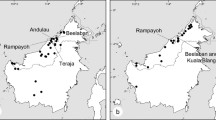Abstract
A guild of 20 late spring- and early summer-flowering species ofIridaceae, Geraniaceae andOrchidaceae is pollinated partly or exclusively by the long-proboscid flyMoegistorhynchus longirostris (Nemestrinidae). This large-bodied fly, active in late spring and early summer, has mouthparts 40–70 (∓90) mm long and forages for nectar from a variety of species. These plants share a suite of convergent floral features including a straight or weakly curved floral tube usually 50–70 mm long but sometimes to 90 mm, relatively short petals or tepal lobes coloured white, cream or salmon with reddish nectar guides, and often violet or red anthers and pollen. Flowers of most species with these characteristics are zygomorphic with the stamens either arcuate (mostIridaceae) or declinate (Geraniaceae and someIridaceae). The flowers are odourless and typically secrete large amounts of nectar of relatively constant sugar concentration, mostly 24–29%, with a high sucrose:hexose ratio. Guild members utilize five separate sites of pollen deposition on the body of the fly, typically utilizing different deposition sites when two or more co-occur, indicating strong selection to aviod pollen contamination.M. longirostris is restricted to the west coast of southern Africa and at least 8 species appear to depend exclusively on the insect for pollination. The remaining species in the guild are pollinated by one or both of the long-proboscid fliesPhiloliche gulosa andP. rostrata (Tabanidae) over other parts of their range. Species and races pollinated entirely byM. longirostris have longer floral tubes which makes nectar unavailable to other insects, including other species of long-proboscid fly. The only insect with mouthparts long enough to forage effectively on these long-tubed flowers isM. longirostris and this fly must be considered a keystone species in the ecosystems in which it occurs.
Similar content being viewed by others
References
Austen, E. E., 1909: Illustrations of African blood-sucking flies. — London: British Museum.
Bernardi, N., 1973: The genera of the familyNemestrinidae (Diptera: Brachycera). — Arq. Zool., S. Paulo24: 211–318.
Darwin, C., 1877: The various contrivances by which British and foreign orchids are fertilised by insects. — New York: Appleton.
Deacon, H. J., Jury, M. R., Ellis, F., 1992: Selective regime and time. — InCowling, R., (Ed.): The ecology of Fynbos: nutrients, fire and diversity, pp. 6–22. — Cape Town: Oxford University Press.
De Vos, M. P., 1982: The African genusTritonia Ker-Gawler (Iridaceae): Part 1. — J. S. African Bot.48: 105–163.
Dierl, W., 1968: Zur Nahrungsaufnahme vonCorizoneura longirostris (Hardwicke). — Ergebn. Forsch. Untern. Nepal-Himalaya3: 70–81.
Dressler, R. L., 1981: The orchids. — Cambridge, London: Harvard University Press.
Fletcher, T. B., Son, S. K., 1931: A veterinary entomology for India, XIV. — Indian J. Vet. Sci. Anim. Husbandry1: 192–199.
Goldblatt, P., 1972: A revision of the generaLapeirousia Pourret andAnomatheca Ker in the winter rainfall region of South Africa. — Contr. Bolus Herb.4: 1–111.
—, 1985: Systematics of the southern African genusGeissorhiza (Iridaceae-Ixiodeae). — Ann. Missouri Bot. Gard.72: 277–447.
—, 1990: Pollination biology ofNivenia (Iridaceae) and the presence of heterostylous self-compatibility. — Israel J. Bot.39: 93–111.
—, 1995: Pollination inLapeirousia subgenusLapeirousia (Iridaceae) in southern Africa; floral divergence and adaptation for long-tongued fly pollination. — Ann. Missouri Bot. Gard.82: 517–534.
Grant, V. E., 1994: Modes and origins of mechanical and ethological isolation in angiosperms. — Proc. Natl. Acad. Sci. USA91: 3–10.
—, 1965: Flower pollination in thePhlox family. — New York: Columbia University Press.
Johnson, S. D., 1992: Plant animal relationships. — InCowling, R., (Ed.): The ecology of Fynbos: nutrients, fire and diversity, pp. 175–205. — Cape Town: Oxford University Press.
—, 1994: Red flowers and butterfly pollination in the fynbos of South Africa. — InArianoutsou, M., Groves, R., (Eds): Plant-animal interactions in Mediterranean ecosystems, pp. 137–148. — Dordrecht: Kluwer Academic Press.
—, 1993: Beauty and the beast, a Cape orchid pollinated by horseflies. — Veld & Flora79: 38–39.
—, 1995: Systematics and evolution of theDisa draconis complex(Orchidaceae). — Bot. J. Linn. Soc.118: 289–307.
—, 1995: Long-proboscid fly pollination of two orchids in the Cape Drakensberg Mountains, South Africa. — Pl. Syst. Evol.195: 169–175.
Lewis, G. J., 1959: The genusBabiana. — J. S. African Bot. Suppl.3. — Cape Town: National Botanical Gardens.
—, 1972:Gladiolus: a revision of the South African species. — Cape Town, Johannesburg, London: Purnell.
Manning, J. C., Goldblatt, P., 1995: Cupid comes in many guises, the not-so-humble fly and a pollination guild in the Overberg. — Veld & Flora81: 50–52.
—, 1996: TheProsoeca peringueyi (Diptera: Nemestrinidae) pollination guild in southern Africa: long-tongued flies and their tubular flowers. — Ann. Missouri Bot. Gard.83: 67–86.
Marloth, R., 1908: Some observations on entomophilous flowers. — S. African J. Sci.5: 110–113.
Nilsson, L. A., 1988: The evolution of flowers with deep corolla tubes. — Nature334: 147–149.
Steiner, K. E., Whitehead, V. V., 1990: Pollinator adaptation to oil-secreting flowers —Rediviva andDiascia. — Evolution44: 1701–1707.
Ogden, E. C., Raynor, G. S., Hayers, J. V., Lewis, D. M., 1974: Manual of sampling airborne pollen. — London: Hafner Press.
Van Der Walt, J. J., 1977: Pelargoniums of southern Africa1. — Cape Town: Purnell.
—, 1981: Pelargoniums of southern Africa2. — Cape Town: Juta.
—, 1988: Pelargoniums of Southern Africa3. — Cape Town: Kirstenbosch Botanical Garden.
Vogel, S., 1954: Blütenbiologische Typen als Elemente der Sippengliederung. — Bot. Stud.1: 1–338.
Whitehead, V. B., Giliomee, J. H., Rebelo, A. G., 1987: Insect pollination in the Cape Flora. — InRebelo, A. G., (Ed.): A preliminary synthesis of pollination biology in the Cape Flora, pp. 52–82. — Pretoria: CSIR.
Author information
Authors and Affiliations
Additional information
Dedicated to emer. Univ.-Prof. DrFriedrich Ehrendorfer on the occasion of his 70th birthday
Rights and permissions
About this article
Cite this article
Manning, J.C., Goldblatt, P. TheMoegistorhynchus longirostris (Diptera: Nemestrinidae) pollination guild: long-tubed flowers and a specialized long-proboscid fly pollination system in southern Africa. Pl Syst Evol 206, 51–69 (1997). https://doi.org/10.1007/BF00987941
Received:
Revised:
Accepted:
Issue Date:
DOI: https://doi.org/10.1007/BF00987941




